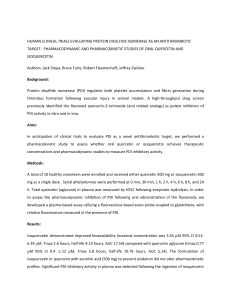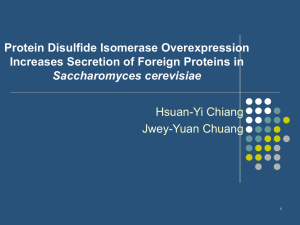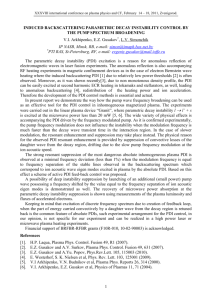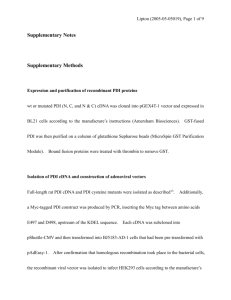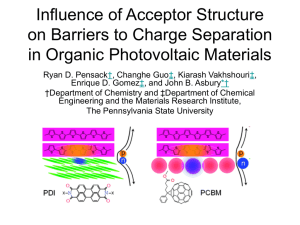ISTH Abstract -IDENTIFICATION OF NOVEL - TRC-THD
advertisement
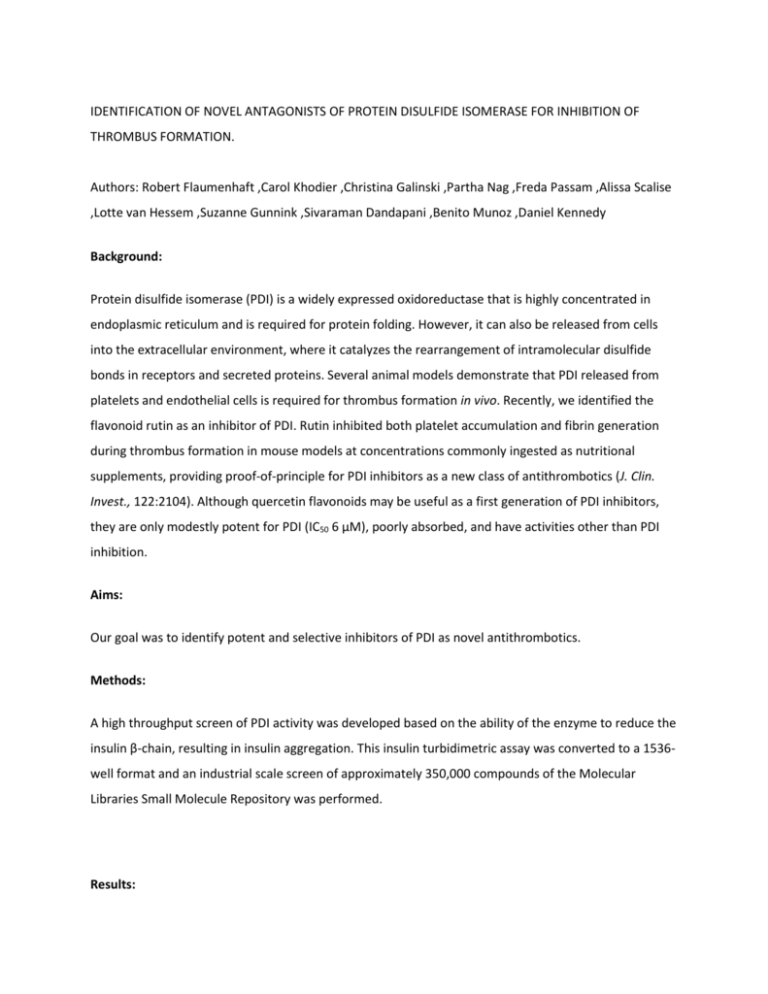
IDENTIFICATION OF NOVEL ANTAGONISTS OF PROTEIN DISULFIDE ISOMERASE FOR INHIBITION OF THROMBUS FORMATION. Authors: Robert Flaumenhaft ,Carol Khodier ,Christina Galinski ,Partha Nag ,Freda Passam ,Alissa Scalise ,Lotte van Hessem ,Suzanne Gunnink ,Sivaraman Dandapani ,Benito Munoz ,Daniel Kennedy Background: Protein disulfide isomerase (PDI) is a widely expressed oxidoreductase that is highly concentrated in endoplasmic reticulum and is required for protein folding. However, it can also be released from cells into the extracellular environment, where it catalyzes the rearrangement of intramolecular disulfide bonds in receptors and secreted proteins. Several animal models demonstrate that PDI released from platelets and endothelial cells is required for thrombus formation in vivo. Recently, we identified the flavonoid rutin as an inhibitor of PDI. Rutin inhibited both platelet accumulation and fibrin generation during thrombus formation in mouse models at concentrations commonly ingested as nutritional supplements, providing proof-of-principle for PDI inhibitors as a new class of antithrombotics (J. Clin. Invest., 122:2104). Although quercetin flavonoids may be useful as a first generation of PDI inhibitors, they are only modestly potent for PDI (IC50 6 μM), poorly absorbed, and have activities other than PDI inhibition. Aims: Our goal was to identify potent and selective inhibitors of PDI as novel antithrombotics. Methods: A high throughput screen of PDI activity was developed based on the ability of the enzyme to reduce the insulin β-chain, resulting in insulin aggregation. This insulin turbidimetric assay was converted to a 1536well format and an industrial scale screen of approximately 350,000 compounds of the Molecular Libraries Small Molecule Repository was performed. Results: The primary screen identified 443 putative PDI inhibitors, which were subsequently tested in 8-point dose curves. Forty-one compounds were identified with IC50s <10 μM. Two compounds, a piperdine (IC50 0.3-0.6 μM) and a bromo indole (IC50 0.6-0.8 μM), were selected for further analysis. To assess the selectively of these compounds, their activity in other bioassays performed within the NIH Molecular Libraries Probe Production Network was evaluated. The piperdine showed no confirmed activity at <10 μM in any of the other of 380 biological assays in which it has been tested. The bromo indole had confirmed activity at <10 μM in only 2 other assays out of 473 in which it had been tested. Within the thiol isomerase family, both compounds demonstrated selectivity for PDI, failing to inhibit either ERp5, ERp57, or thioredoxin. The piperdine was soluble at 65 μM in aqueous solution and demonstrated 97% stability in GSH at 48 h, indicating that the compound did not inhibit PDI by interacting with the CxxC catalytic domain. The bromo indole was soluble at 81 μM and demonstrated 99% stability to GSH. Consistent with this observation, inhibition of PDI by the piperdine and the bromo indole was entirely reversible. Neither compound demonstrated toxicity in a HeLa cell assay at 20-fold their IC50s. Organic synthesis of 31 analogs of the piperdine lead was performed and structure activity relationships determined. In preliminary in vivo studies, the piperdine inhibited platelet accumulation in cremaster arterioles following laser injury. Conclusions: The compounds identified in this screen will serve as leads for the development of a second generation of PDI inhibitors as a new class of antithrombotics with improved potency and specificity compared with quercetin flavonoids.



